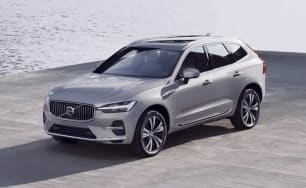Families will appreciate the XC60's cabin. Both rows of seating are roomy for the class and the front seats are supportive and comfortable with multiple adjustments available.
However, there is an electric toggle dial that controls the lumbar-, side-, and under-thigh supports as well as the massage function, but flipping between modes can be a bit confusing at first.
I enjoy having the practical two-position memory function on both front seats, as I’ve been travelling a lot with my husband and the heat/ventilation features on the front seats have been great during a recent run of strange weather.
The back seats are well-cushioned and the bench is wide with three adults being able to sit without too many grumbles.
I have plenty of room for my 168cm height and my seven-year old is able to get in and out without any trouble thanks to the higher ground clearance.
Our absolute favourite feature is built-in child booster cushions in the outboard seats. They have two height positions to accommodate different heights/weights and it’s been wonderful for my son to have the autonomy of buckling himself in. But also just awesome for my husband and I because it’s one less thing to think about!
Storage throughout the car is good for the class with the front enjoying a mid-sized middle console, large glove box, two cupholders and two large drink bottle holders. The extra-large storage bins in the front doors are also very handy.
In the rear, you have two retractable cupholders in the fold-down armrest, two map pockets and two drink bottle holders in each door.
The other amenities are great with the individual climate control and four sets of directional air vents – ideally located on the back of the centre console and on the B-pillars.
Charging options are solid with both rows enjoying two USB-C ports and the front also getting a 12-volt outlet and wireless charging pad. The boot has a 12-volt socket, too.
Onto the other technology, the 9.0-inch touchscreen multimedia system is responsive and relatively easy to get around once you spend some time with it. Along with the Google subscription, you also get wired Apple CarPlay and Android Auto.
The 12.3-inch digital instrument cluster shows the navigation map and the head-up display incorporates directions, which is great.
The cluster itself isn’t customisable, though, and I like fiddling with things like that to personalise the driving experience.
Another practical feature is a secondary key fob which can be programmed to control the maximum speed the car can travel and the audio volume.
I'm sure this would be handy for parents of any P-platers out there who often borrow the family car.
The key fobs are easily distinguishable. too. The spare for our test vehicle is a bright orange colour, so there are no 'whoops, I grabbed the wrong key' arguments, either.
The boot space is a great size at 483L offering plenty of room for holiday luggage. The back seat has a 60/40 split and a ski-port to open up storage options.
The loading space is level and there is a temporary spare tyre underneath the floor. You can adjust the height of the car using the air suspension and I love a powered tailgate.

